
The young, just hatched chicken – the creature is in many respects underdeveloped, but in general it is very similar to the parents. He, like them, already has wings, legs and eyes. And out of the bee-egg, a small white worm without a head, eyes, wings and without legs, has no the slightest resemblance to the mother.
When the larva of the bee or the caterpillar of the butterfly grows up, it turns into a pupa. Outwardly this is the stage of rest, but in fact – the stage of intense internal restructuring and transformation. It lasts as long as the doll finally resets its chitin shell and as a result of the last molt not winged insect appears. It can not continue to grow, because it no longer sheds. Widespread mistake – to consider a small beetle young. A young beetle looks like a yellow worm or a whitish larva.
But back to the bees. If, at a favorable time of the year, to search the uterus in a specially adapted observation hive, then, as a rule, it can be detected slowly, almost majestic strolling along the honeycomb and laying eggs. In the spring, one prolific uterus may postpone about 1500 eggs per day, that is, on average, it lays an egg every minute. In fact, she has a respite, and in the interval between them, egg laying is much faster. However, bee eggs are relatively small. Each 1500 eggs laid by their total weight are equal to the weight of the uterus. It is clear that she is not able to do anything else.
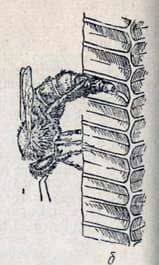
Fig. 20. Uterus for laying eggs. b – just laying an oblong egg on the bottom of the cell, the uterus prepares to pull out of it the abdomen.
When laying eggs, the uterus behaves as follows: first it puts a head in the cell, and, making sure that the cell is empty and ready to receive the egg, lowers the abdomen into it. Then she freezes for a few seconds and again pulls out the abdomen from the cell, at the bottom of which remains an oblong egg. And the uterus is already looking for a new cell for the next egg.
One should not, however, think that the queen wanders through all cells indiscriminately, laying eggs here and there. This would be very sad for the beekeeper, too, because, selecting each honeycomb, it would destroy part of the brood, and for the buyer of such honeycombs, since he would see white worms in them. In laying eggs, a certain order prevails, consisting in the fact that the uterus takes only the front and middle honeycombs in the hive with eggs, and in them only the middle parts, leaving the edges free. Thus, a “brood nest” is formed, the approximate dimensions of which in a single hive during the intensive growing of bees are shown in Fig. 21.
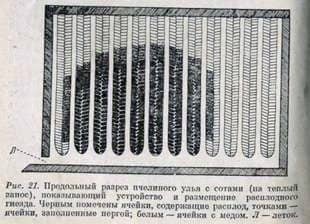
Black cells contain eggs and larvae of bees. If we take such a honeycomb from the hive, we will see that its middle part is also filled with brood.
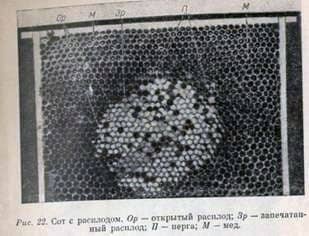
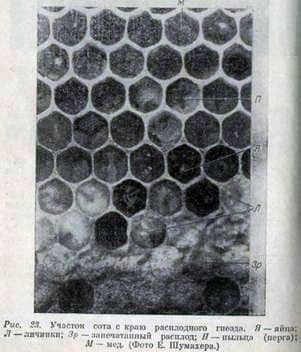
In adjacent cells, the bees store the stocks of flower pollen (pergus), so that the brood section is fringed with a wreath of cells with pergoy (in Figure 21 it is filled with black dots, and in Figures 22 and 23 it is denoted by the letter P); at the edges of the brood honeycomb and in all cells of honeycombs located in front of and behind the brood nest, and in many hives and above it, honey is deposited. When harvesting, the beekeeper can take from his bees honeycomb filled with only one honey. But he should not select them all, it is necessary to calculate what supply of food the family will need for the winter, and only the excess of honey can be used for their needs.
A small white larva hatchs out of the egg laid by the uterus after three days (see Figure 23). Working bees immediately supply it with food, and it develops such an appetite that in six days it completes its growth.
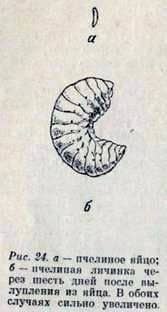
Figure 24 accurately shows the actual ratio of the size of the egg and the six-day larva. In six days the weight of the larva increases more than 500 times. As applied to a person, this would mean that a newborn baby would reach 1,600 kilograms in six days. Then comes the stage of external peace, which ends the transformation of the larva into an adult bee. Working bees are now building above the cell a delicate convex lid of wax, and at the same time the larva, as if wishing to emphasize that she needs complete peace, spins under this wax lining a thick yarn corresponding to the cocoon that the caterpillars of many butterflies harvest before their pupation.
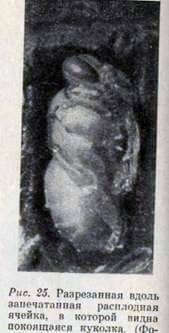

The beekeeper calls this stage a “closed brood”, in contrast to the growing “open brood” (see Figures 22 and 23). In the closed cell, the larva pupates, and 12 days after the beginning of the resting stage, just three weeks after the egg is laid, the cap is torn and an adult winged bee leaves the cell.
Since the uterus lays eggs from early spring to late autumn, from about the beginning of March and often until October, the brood of all age stages can be found in the family. In the summer months, over a thousand young bees leave the fruit combs. True, the daily departure of old bees that have reached the natural limit of their lives or prematurely dying during the flight for a bribe is almost as great. The brood cells from which the bees hatched, the uterus soon again sows with eggs.
The departure of worker bees for brood is not limited to those six days of growth of the larva, when it needs to be fed.
The brood needs to be taken care of, starting from the egg stage and before the hatching of the bee, because for its normal development a uniform temperature of 35 degrees is required, which is created and maintained by working bees in the area of the brood nest. To clarify this, we will have to make a small digression.
The normal temperature of the human body, to which all of its life processes are adapted, is maintained with minor deviations at night and day, in summer and in winter at about 37 degrees. This is possible only due to the constant temperature control occurring in a very complicated way and in most cases in addition to our will.
If the body temperature rises above the norm by a fraction of a degree, the skin begins to be intensively supplied with blood to increase heat transfer; that’s why when overheating the face turns red, the internal heat decreases and we begin to sweat. The sweat evaporates, and the body cools. If the body temperature is too low, then as a result of redistribution of blood, heat loss decreases and more heat is produced due to increased burning of fat and sugar – combustible substances of the body. If we begin to tremble, it is nothing more than an involuntary muscle movement, the only purpose of which is the production of heat.
The ability to regulate the temperature, in addition to man, has mammals and birds. But, for example, in a lizard, swift under the sun, warming her blood, the body temperature on a cool evening goes down, and she becomes sleepy and lazy. Insects are also animals with a “volatile” body temperature, which strongly depends on the outside temperature. The bees have a special way. Strengthening the metabolism in the pectoral muscles, they very quickly, within a matter of minutes, can raise the temperature of their body by several degrees.
So they act, for example, before departure. Of course, in the cold air, bees can not protect themselves from rapid loss of heat, and if in the evening there is a sudden cooling, then already at 8-10 њ the bees can not move. But in a hive, in the area where the brood is located, where bees accumulate in thousands, they constantly maintain an almost unchanged temperature of 35 њ.
At the slightest cooling they heat their bodies, which become 10 њ warmer than their environment, these “living stoves” and give all the heat they produce. To do this, the bees gathered on the honeycomb are closely pressed against each other and their cells, like downy feathers, close the cells with brood. On warm days, the whole society is dispersed. But if the temperature continues to rise despite this, bees bring water to the beehive (after all, they can not sweat) and, covering the honeycomb with the finest water film, evaporate this water, ventilating the beehive with its wings. The stoves turned into fans, which drive the superheated air to each other and direct it through the chute to the outside.
The unmistakable sense of temperature and the well-organized interaction of all bees in the family are prerequisites for this amazing ability.
So far, we have talked simply about bee brood, not taking into account the fact that in the family of brood, three kinds of creatures – the uterus, drones and worker bees – should develop. Strictly speaking, the data given above on the development dates refer only to worker bees. In order to turn from an egg into an adult bee, the uterus is required for five days less, and the drones – for three days more.

Fig. 27. Section honeycomb with two queen cells, in each of which the uterus is grown.
Whether the working bee or uterus will develop from an egg depends on the working bees that care for the larva. Like themselves, they grow in ordinary, narrow honeycomb cells, and for a few larvae, from which the uterus should grow, they build cells much more spacious. These cradles of future queen beekeepers are called queen cells. But the decisive importance for the future of the growing female larvae is nutrition. Larvae of worker bees in the first days of life receive royal jelly high-nutrient secretion of the transformed salivary glands that perform in bees the same role that mammary glands in mammals. With age, the food of the larvae becomes more rough: they receive an additive in the form of pollen and honey.
Larvae-the future uterus-feed exclusively on royal jelly, which bees supply them in much larger quantities than other larvae, and which has a different chemical composition. It turned out that certain biologically active substances (pantothenic acid, bioptner) are contained in royal jelly intended for future queens, about 10 times greater than in the milk produced by the larvae of worker bees. But the real magic, thanks to which the larva develops the uterus, has not yet been discovered by anyone.
The uterus lives four to five years, and the life of worker bees is calculated in weeks or at best months. Therefore, many people think that by taking royal jelly, they are likely to be able to extend their earthly existence somewhat. Organizing the artificial withdrawal of queens, this motherfish can be extracted in large quantities and stored for a long time due to special treatment.
Uterine fodder was tested in clinics and sanatoriums, and it is often necessary to hear about its beneficial effect on people weakened by severe illness, as well as with senile weakness, arthritis and other diseases. Royal jelly is sold everywhere for a lot of money – of course, with the benefit for its suppliers. However, whether it really has special healing properties, has not yet been elucidated.
Uterus and worker bees are female creatures. Whether one of these individuals or a bee of a male saw will come out of an egg depends on the uterus at the time of egg laying. The thing is this.
In the first week of life the uterus during mating departure mates with drones. Since then, in the seminal vesicle in her abdomen, male sex cells have been preserved for life, which for many years remain alive and capable of fertilization. The seminal vesicle is connected by a narrow channel with a passage through which eggs are deposited.
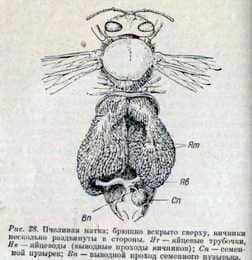
Due to the precisely working mechanism, the uterus can release several seed threads from the vial when passing the egg, then the egg will fertilize. She may not do this, then the egg is postponed unfertilized. Of unfertilized eggs, males develop, and from the fertilized eggs females (uterus or working bee) develop. What explains in this case the dependence of sex on fertilization, we do not know this. This definition of sex is not a common phenomenon. Moreover, it is a rare feature peculiar to a few insects.

So, to appear in the world of drones or not – the solution of this question is dominated by the uterus. But working bees can also have an effect on this: drones are larger than working bees, and therefore large cells are needed for growing the tartar brood. These cells and must build working bees. The trotney cells differ from all others only in considerably larger sizes. But first they must be prepared, and then the uterus lays in them unfertilized eggs. Thus, even here the main role is played by worker bees, and the uterus is only their tool.
Обработка щавелевой пчел. Пчелы темные.
The bee family and its composition